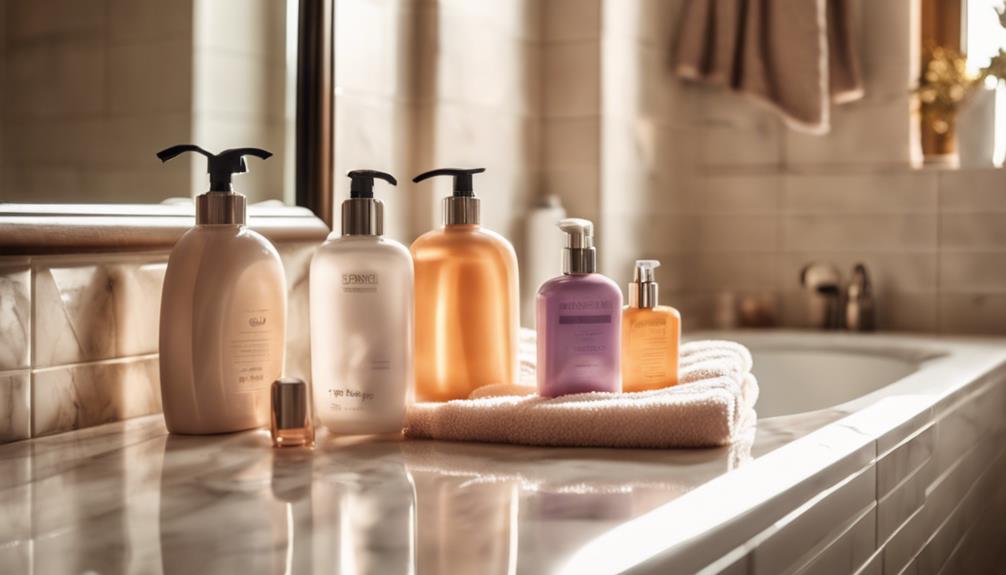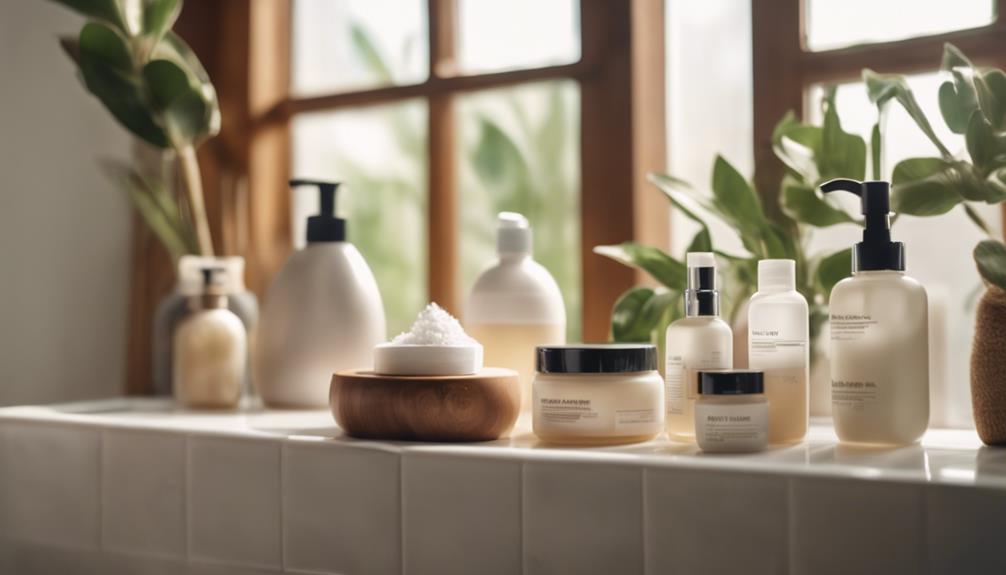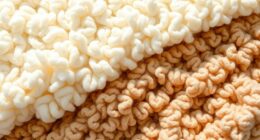To guarantee your homemade beauty products stay safe and effective, you should consider using natural preservatives. Benzyl alcohol and potassium sorbate are top choices, offering protection against microbial growth. Rosemary extract and grapefruit seed extract also provide antimicrobial benefits. Additionally, Leucidal Liquid SF, derived from fermented radish, effectively fights contamination. Vitamin E can extend the shelf life of oil-based products. Combining these options strategically enhances their efficacy. By monitoring pH levels and conducting microbial tests, you can create well-preserved cosmetics. Want to discover more tips on preserving your homemade products successfully?
Key Takeaways
- Benzyl alcohol and potassium sorbate are effective natural preservatives for water-based beauty products, preventing microbial contamination.
- Rosemary extract and grapefruit seed extract provide antimicrobial and antioxidant benefits, enhancing product longevity and safety.
- Leucidal Liquid SF and NataPres effectively inhibit microbial growth, making them excellent choices for preserving homemade cosmetics.
- Essential oils like lavender and tea tree offer natural antibacterial properties, complementing other preservatives for added protection.
- Conduct microbial testing and monitor pH levels to ensure the effectiveness and safety of your natural preservative choices.
Importance of Natural Preservatives
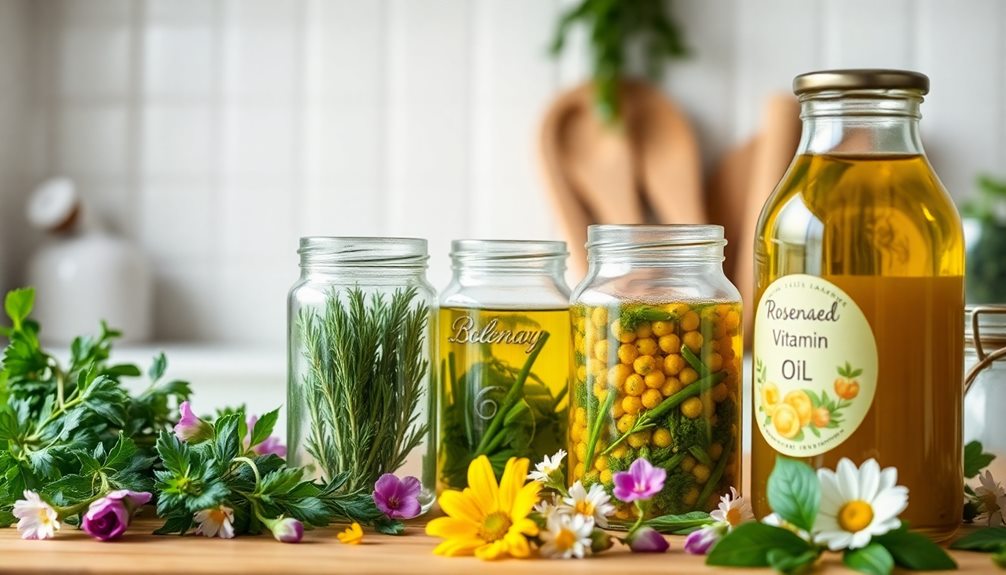
Why are natural preservatives so vital in beauty products? When you create or use water-based beauty products, they can be prone to microbial contamination. This is where natural preservatives come into play. Ingredients like potassium sorbate and benzyl alcohol not only help protect your products from harmful microorganisms but also guarantee their longevity and product integrity.
The risk of contamination increases considerably in unpreserved cosmetics, especially those with moisture. By opting for natural preservatives, you align with the growing demand for clean beauty products, steering clear of synthetic alternatives that may pose health risks.
When formulating homemade beauty products, understanding the specific usage rates and compatibility of these natural preservatives is essential. This knowledge helps achieve peak effectiveness and stability in formulations, guaranteeing your creations remain safe and effective for use.
Incorporating natural preservatives isn't just about safety; it's about delivering products you can trust. So, whether you're crafting your own beauty treats or selecting products off the shelf, prioritize natural preservatives to maintain quality and peace of mind.
Selecting Effective Preservatives
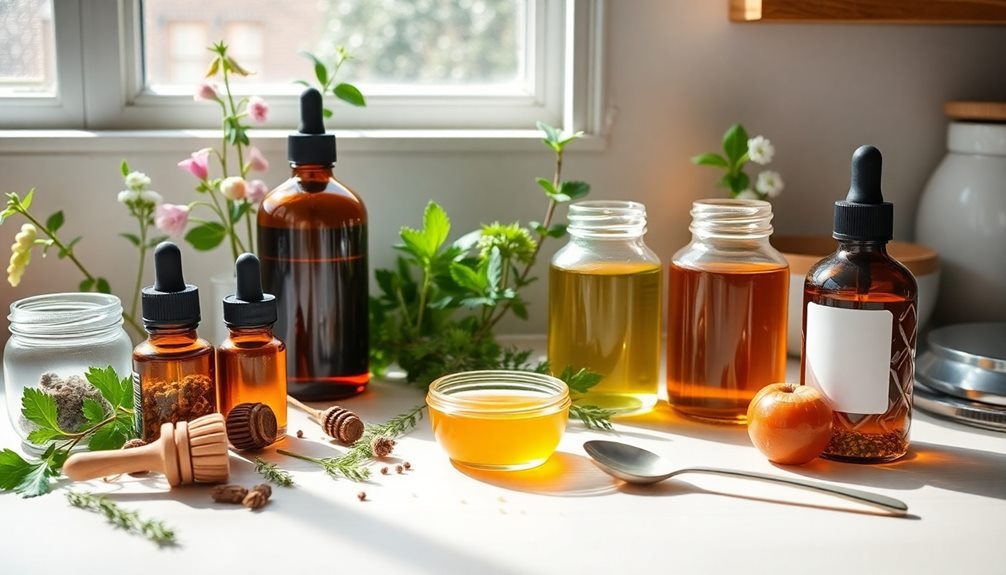
When you're selecting effective natural preservatives, keep in mind their ability to combat bacteria, mold, and yeast.
You'll want to evaluate common options like Leucidal SF and Geogard ECT, ensuring they fit well with your formulation's pH and other ingredients. You’ll also need to test their efficacy in providing adequate preservation to extend your product’s shelf life while maintaining safety and quality. Keeping an eye on trends, such as the latest advancements in the best hair styling tools 2025, can also inspire innovation in your formula, particularly if you’re creating complementary haircare products. By thoroughly researching and conducting stability tests, you can select the preservative that aligns seamlessly with your formulation’s performance goals.
Key Considerations for Selection
Selecting effective natural preservatives for your beauty products requires careful consideration of several key factors. First, you need to assess the solubility of the natural preservatives in relation to your formulation ingredients. This plays a vital role in their effectiveness, especially in water-based products.
Next, evaluate the broad-spectrum efficacy of the preservatives against bacteria, mold, and yeast. This guarantees extensive protection for your homemade beauty products.
It's also essential to take into account the ideal working pH range for each preservative. This can greatly impact their antimicrobial effectiveness, so knowing the pH compatibility is key.
Additionally, consider how your chosen preservatives may interact with other formulation ingredients. This helps avoid redundancy and guarantees that the preservative's efficacy isn't diminished.
Familiarizing yourself with common natural preservatives like Leucidal SF and Phytocide Elderberry OS is beneficial. Each of these has unique properties and compatibility requirements that can influence your final product.
Common Natural Preservatives
Natural preservatives play an essential role in extending the shelf life and safety of your beauty products. When crafting homemade beauty products, consider incorporating effective natural preservatives to protect against microbial growth and oxidation.
Benzyl Alcohol is a popular choice due to its efficacy against various microorganisms and its natural presence in essential oils. For water-based formulations, Potassium Sorbate works well to inhibit microbial growth.
If you're creating acidic products, Sodium Benzoate is an excellent option, preventing microbial proliferation effectively.
Rosemary Extract not only offers antimicrobial properties but also provides antioxidant benefits, enhancing both the shelf life and safety of your formulations.
Similarly, Grapefruit Seed Extract boasts broad-spectrum antimicrobial activity, making it suitable for combating bacteria and mold in various cosmetic applications.
Don't forget about Vitamin E, which acts as an antioxidant, preventing rancidity in oils while also supporting skin health.
Evaluating Efficacy and Compatibility
Understanding how to evaluate the efficacy and compatibility of natural preservatives is key to formulating safe and effective beauty products. Start by considering the solubility of the preservatives in your formulation. Look for those offering broad-spectrum protection against bacteria, mold, and yeast.
Here's a quick reference table to guide you:
| Preservative | Recommended Usage Rate | pH Range | Compatibility |
|---|---|---|---|
| Leucidal SF Complete | 2-4% | 4.0 – 7.0 | Moderate |
| Phytocide Elderberry OS | 2-4% | 4.0 – 6.5 | High compatibility |
| Geogard ECT | 1-3% | 3.0 – 7.0 | Moderate |
| Sodium Benzoate | 0.5-1% | 4.0 – 7.0 | Low compatibility |
Always check the recommended usage rates to guarantee preserving efficacy. Conduct microbial testing on your finished products to validate the effectiveness of your chosen natural preservatives. This guarantees your homemade beauty products remain safe and effective throughout their shelf life.
Testing and Experimentation
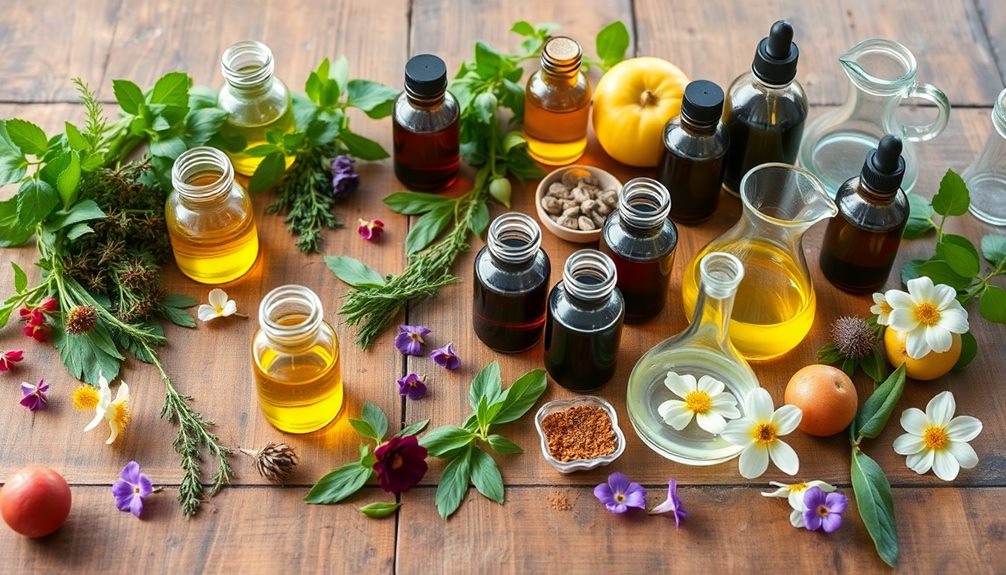
When testing your homemade beauty products, conducting microbial tests at home can be eye-opening.
These tests reveal the presence of bacteria and mold, emphasizing the need for effective natural preservatives. By creating control lotions with and without preservatives, you can clearly compare microbial growth and gauge the efficacy of each option.
Here are four key points to keep in mind during your experimentation:
- Monitor Stability: Some natural preservatives may offer a shorter shelf life than synthetic alternatives.
- Combine Preservatives: Research indicates that blending Leucidal Liquid SF with AMTicide Coconut can enhance protection against bacteria and mold.
- Track Efficacy: Regularly assess the effectiveness of your chosen preservatives to guarantee your homemade products remain safe.
- Document Results: Keep a detailed record of your tests, noting what worked and what didn't for future reference.
Top Natural Preservatives
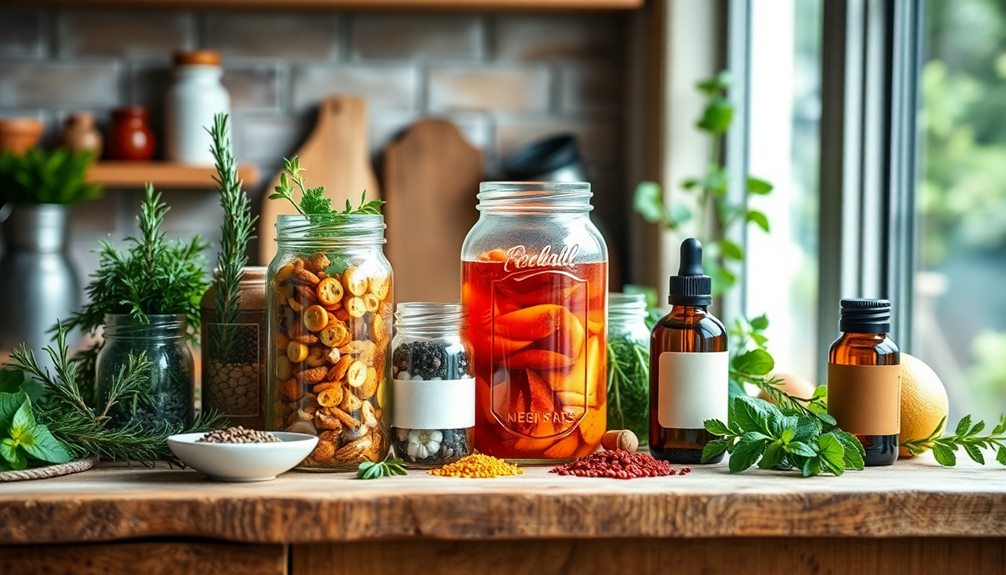
When you're crafting beauty products, choosing the right natural preservatives is essential for maintaining freshness and efficacy.
Effective options like Leucidal Liquid SF and Rosemary Oil Extract not only extend shelf life but also enhance your formulations.
Let's explore these preservation strategies and see how they can benefit your creations.
Effective Natural Options
Natural preservatives offer effective solutions for maintaining the integrity of beauty products, ensuring they stay safe and effective for use. When you're crafting your homemade beauty products, consider these top natural options:
- Leucidal Liquid SF: This powerful preservative, derived from fermented radish root, shows no microbial growth in tests, making it perfect for lotions and creams.
- NataPres: A nature-derived preservative that maintains product integrity, preventing microbial contamination in various formulations.
- Phytocide Elderberry OS: Known for its antimicrobial properties, it requires careful usage to keep bacterial and mold growth at bay.
- Grapefruit Seed Extract: This ingredient provides broad-spectrum antimicrobial activity while adding a pleasant aroma, enhancing the appeal of your products.
Additionally, Vitamin E extends the shelf life of oil-based formulations by slowing rancidity, though it works best when combined with true preservatives.
Preservation Strategies Explained
Often, choosing the right preservation strategy is essential for extending the shelf life of your beauty products. Natural preservatives like Leucidal Liquid and NataPres effectively combat microbial growth in water-based cosmetics, ensuring product safety. When formulating your homemade beauty products, consider incorporating essential oils such as tea tree and lavender. They offer natural antifungal and antibacterial properties, enhancing preservation.
Here's a quick overview of some top natural preservatives:
| Natural Preservatives | Benefits |
|---|---|
| Grapefruit Seed Extract | Broad-spectrum antimicrobial activity |
| Rosemary Oil Extract | Antioxidant benefits and antimicrobial |
| Essential Oils (e.g., Lavender) | Natural antifungal and antibacterial properties |
It's vital to remember that natural preservatives require careful formulation for effectiveness. Their potency can vary widely based on source and processing methods, making stability testing necessary to confirm safety against microbial contamination. With the rising demand for clean beauty, many consumers prefer these natural options for their safety and environmental benefits. By choosing the right strategies, you can create effective and safe homemade beauty formulations that align with clean beauty principles.
Enhancing Preservation Efficacy
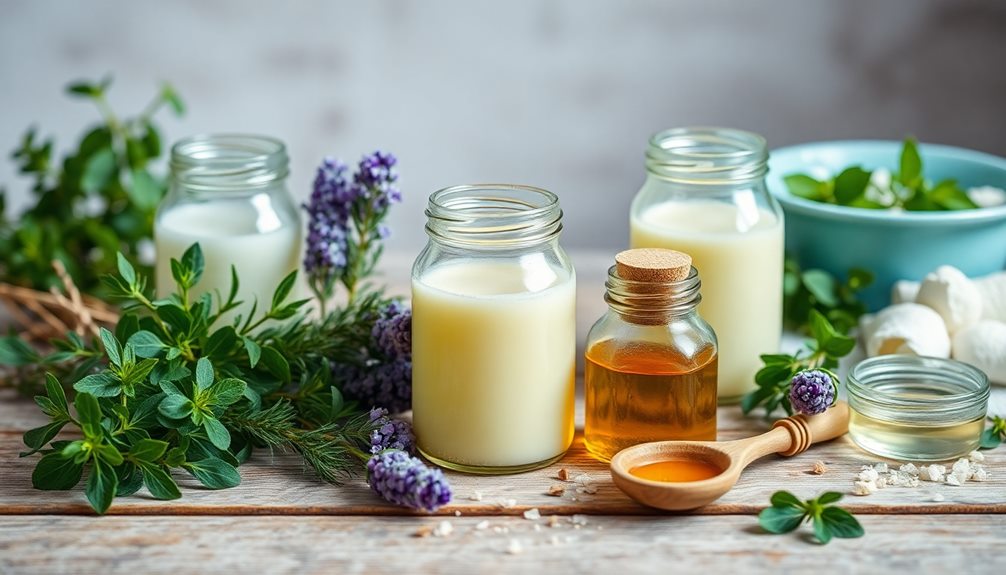
To enhance the preservation efficacy of your beauty products, consider incorporating preservative boosters like glyceryl caprylate.
These boosters improve the wetting properties of natural preservatives, allowing them to work more effectively against microbial growth. Combining different natural preservatives, such as Leucidal Liquid SF and AMTicide Coconut, can greatly increase overall effectiveness.
Here are four essential tips to boost preservation efficacy:
- Monitor formulation temperature: Keep it below 104°F (40°C) to maintain the potency of your preservatives.
- Understand pH range: Many natural preservatives require specific pH levels for maximum effectiveness against bacteria, mold, and yeast.
- Evaluate ingredient interactions: Regularly check how your ingredients interact to prevent redundancy in preservation methods.
- Focus on stability and longevity: Aim for formulations that enhance the stability and longevity of your homemade beauty products.
Regulatory Considerations
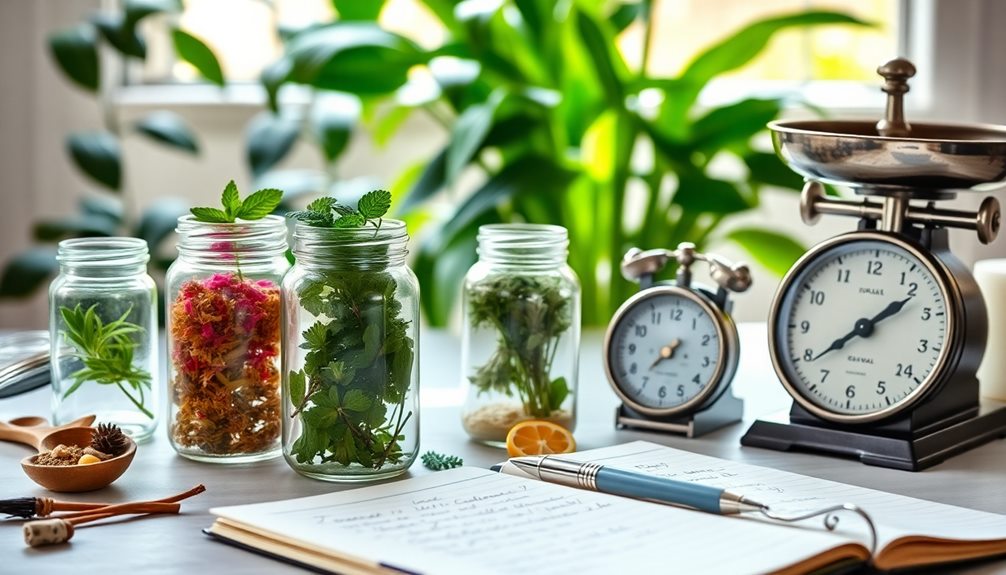
Maneuvering the regulatory landscape for beauty products can feel intimidating, especially when it comes to using natural preservatives. Regulatory bodies like ECOCERT, COSMOS, and NATRUE have set stringent standards to guarantee the safety and efficacy of these ingredients.
As a formulator, you need to be aware that many natural preservatives require documentation from suppliers to prove compliance with these regulations, especially for global distribution.
With growing consumer demand for transparency regarding ingredient sourcing and safety, the clean beauty market is experiencing stricter regulatory oversight. You must guarantee that the natural preservatives in your products are properly labeled and adhere to regional regulations. This not only helps you avoid legal issues but also maintains consumer trust.
Ongoing education about natural preservatives and their regulatory status is vital. Staying informed allows you to align your formulations with industry standards and meet consumer expectations.
Frequently Asked Questions
What Are Natural Preservatives for Homemade Skincare?
Natural preservatives for homemade skincare include essential oils like tea tree and lavender, plus extracts like grapefruit seed and rosemary. They help prevent microbial growth, ensuring your products stay safe and effective for longer.
What Is the Most Effective Natural Preservative?
When considering the most effective natural preservative, you should look at options like Leucidal Liquid SF and NataPres. They both prevent microbial growth, ensuring your formulations stay safe and effective for longer periods.
What Is the Safest Preservative for Cosmetics?
When you're considering safety in cosmetics, look for natural preservatives like Potassium Sorbate and Sodium Benzoate. They protect against bacteria and mold while maintaining your product's integrity, ensuring a safe experience for you and your skin.
How to Prevent Mold in Homemade Beauty Products?
To prevent mold in your homemade beauty products, use distilled water, maintain a sterile environment, make smaller batches, store them in cool, dry places, and regularly check for spoilage or environmental changes.
Conclusion
Incorporating natural preservatives into your homemade beauty products is vital for maintaining their quality and safety. By selecting the right ingredients and experimenting with combinations, you'll create effective formulations that stand the test of time—like grandma's secret jam recipe that never spoils. Remember to stay updated on regulations to guarantee your creations are compliant. With the right approach, you can enjoy the benefits of natural beauty while keeping your products fresh and fabulous!


